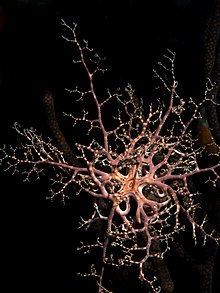Astrophyton
| Astrophyton | |
|---|---|

| |
| Scientific classification | |
| Domain: | Eukaryota |
| Kingdom: | Animalia |
| Phylum: | Echinodermata |
| Class: | Ophiuroidea |
| Order: | Phrynophiurida |
| Family: | Gorgonocephalidae |
| Subfamily: | Gorgonocephalinae |
| Genus: | Astrophyton Fleming, 1828 |
| Species: | A. muricatum
|
| Binomial name | |
| Astrophyton muricatum (Lamarck, 1816)
| |
| Synonyms | |
|
Euryale muricatum Lamarck, 1816 | |
Astrophyton muricatum, the giant basket star, is an echinoderm found in shallow parts of the tropical western Atlantic and throughout the Caribbean Sea and the Gulf of Mexico.[1] It is the only species in the genus Astrophyton.[2] During the day, it curls up into a tight ball shape to protect itself from predators. At night, it climbs to an elevated point to feed by extending its intricately branched feeding arms in a bowl-like shape in order to snare passing plankton and other organisms from the current.
Description
The giant basket star is a very large echinoderm that can reach a diameter of nearly a metre when its arms are fully extended. It has a central disc and eight slender, flexible arms that repeatedly divide to form a fine-meshed net-like structure. The colour is generally brown or black.[3]
Distribution and habitat
This basket star is found in warmer regions of the western Atlantic Ocean, the Caribbean Sea and Gulf of Mexico. Its range extends from Cape Lookout in North Carolina to the coast of Brazil at about 20°S. It is found at depths down to about 30 m (98 ft). Although it is usually found on coral reefs, it also occurs on the top of boulders or in seagrass meadows.[4]
Behaviour

The species is nocturnal and spends the day in a hiding place. It only feeds when the water conditions are optimal. When the current is too strong it keeps its arms folded up but at moderate current speed it climbs to an elevated position and spreads its arms wide.
The shrimp Periclimenes perryae often lives in association with the giant basket star, and larger individuals are usually coloured to match the colour of the basket star.[3]
References
- ^ Encyclopedia of Life: Astrophyton muricatum
- ^ Sabine Stöhr & Hans Hansson (2012). Stöhr S, O'Hara T (eds.). "Astrophyton Fleming, 1828". World Ophiuroidea database. World Register of Marine Species. Retrieved February 25, 2012.
- ^ ISBN 978-0-86622-875-6.
- ISBN 978-90-6191-228-6.
- ^ ISBN 978-90-6191-141-8.
External links
- Odd looking marine animals
- Photos of Astrophyton on Sealife Collection
